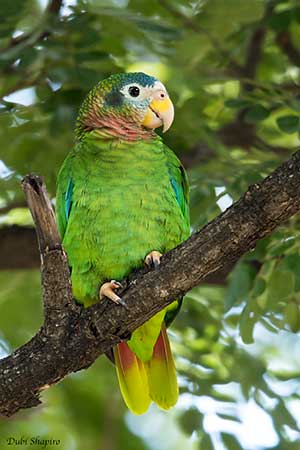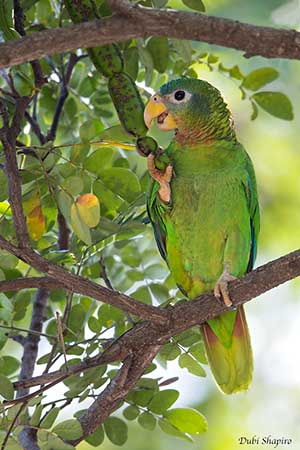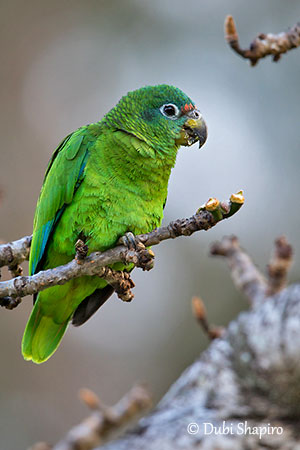
PROTECTION / THREATS / STATUS:
The Yellow-billed Amazon has restricted range in Jamaica. The species is threatened by habitat destruction through forest clearance, shifting cultivation, bauxite mining and trapping for cage-bird trade, but also for local consumption.
Some captive breeding populations are part of current conservation measures.
The population is roughly estimated to number 6,000/15,000 mature individuals. It is slowly declining due to trapping and habitat loss.
The Yellow-billed Amazon is currently classified as Vulnerable.
Fr: Amazone sasabé
Ang: Yellow-billed Amazon – Yellow-billed Parrot
All: Jamaikaamazone
Esp: Amazona Jamaicana Piquiclara
Ita: Amazzone beccogiallo
Nd: Geelsnavelamazone
Sd: gulnäbbad amazon
Photographer:
Dubi Shapiro
Dubi Shapiro Photo Galleries & Dubi Shapiro's Pictures on IBC
Text by Nicole Bouglouan
Sources:
HANDBOOK OF THE BIRDS OF THE WORLD vol 4 by Josep del Hoyo-Andrew Elliott-Jordi Sargatal - Lynx Edicions - ISBN: 8487334229
PARROTS OF THE WORLD – An Identification Guide – by Joseph M. Forshaw – Princeton University Press – ISBN 0691092516
BIRDS OF THE WEST INDIES – by Herbert Raffaele, Kristin Williams et Tracy Pedersen – Helm – ISBN: 9780713649055
Wikipedia, the free encyclopaedia
Neotropical Birds – Cornell Lab of Ornithology
REPEATING ISLANDS - News and commentary on Caribbean culture, literature, and the arts
Yellow-billed Amazon
Amazona collaria
Psittaciformes Order – Psittacidae Family
INTRODUCTION:
The Yellow-billed Amazon is endemic to Jamaica where it frequents wet forest of hills and mountains at mid-elevations. It feeds on fruits, berries and seeds and some other plant material. It nests in cavities, often holes in trees.
The Yellow-billed Amazon is threatened by habitat destruction and trapping for the pet trade. It is currently classified as Vulnerable.
DESCRIPTION OF THE BIRD:
Biometrics:
Length: 28 cm
The Yellow-billed Amazon has green plumage overall with black-edged feathers of crown to mantle and head sides. On the upperwing, primaries and secondaries are blue. The uppertail is green with narrow yellowish terminal bar and red-edged outer rectrices. Rump and uppertail coverts are yellowish green.
On the underparts, the breast is green whereas belly and undertail-coverts are yellowish-green. The undertail is broadly reddish at base and yellowish green at tip. The underwing coverts are green. The flight feathers are pale blue green. The wingtip is blackish-blue. Chin, throat and neck sides are pink.
On the head, forehead and area around the eyes are white. The forecrown is dull blue, whereas lores and upper cheeks are pale blue. The ear-coverts are greyish-blue. The lower part of the cheeks is pale pink.
The hooked bill has yellow base with paler tip. The eyes are dark brown, surrounded by white eyering. Legs and feet are pink with black claws.
Male and female are similar.

The juvenile/immature resembles adult, but it has greyish upper mandible with yellowish base and lower mandible. The plumage is green overall, including on the underparts.
The head is mainly green with some red feathers on the forehead above the bill base, and blue-green tinge around eyes and on ear-coverts. The eyering is white.
RANGE:
The Yellow-billed Amazon is endemic to Jamaica where it is found in Cockpit Country, Mount Diablo and John Crow Mountains. A small population is established at Hope Gardens in Kingston.
HABITAT:
The Yellow-billed Amazon is usually found at mid-elevations, up to 1,200 metres. But the species is also present at sea-level where it frequents semi-wooded habitats and cultivated areas. But it is mainly seen in wet forests of hills and mountains. During the breeding season, it is often confined to closed forests. Outside this period, it forages in more open areas.
CALLS AND SONGS: SOUNDS BY XENO-CANTO
The Yellow-billed Amazon in flight gives a bugling “tuk-tuk-tuk-taaah” with more prolonged last syllable. When perched, it gives a high-pitched “tah-tah-eeeeep”. Low-pitched or rolling squawks are also part of the repertoire.
BEHAVIOUR IN THE WILD:
The Yellow-billed Amazon feeds on fruits, berries, seeds, blossoms and leaf buds. It is sometimes considered a pest to gardens and plantations as it also takes cultivated fruit crops.
It feeds in mid to upper levels of forest. It is usually seen in large flocks outside breeding season and they use communal nightime roosts. They leave them at sunrise after a loud calling. They disperse over long-distances to reach their feeding areas.

Within the feeding flocks, some amazons can be seen high in trees, perched on exposed branches. These “sentinels” are ready to warn the flock of danger.
They feed again in the late afternoon and they return to the roost at dusk.
The Yellow-billed Amazon is usually confined to closed forests during the breeding season. Like most Psittaciformes, it nests in cavities, and often in tree holes.
This species is resident but it wanders widely in search of food.
It flies with shallow, slow wingbeats, below the plane of the back.
REPRODUCTION OF THIS SPECIES:
The breeding season takes place from March to July, although nestlings are reported in October too.
The Yellow-billed Amazon nests high in tree. It often uses a hole in tree trunk, or an abandoned woodpecker cavity, or occasionally nests in rock crevice. The nest is usually at least 18 metres above the ground.
The female lays 3-4 white eggs. The incubation lasts 24-25 days, probably shared by both adults. The nesting period is long and lasts about ten weeks.
